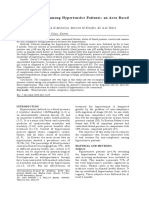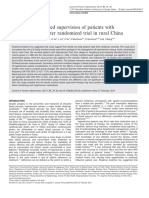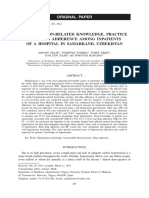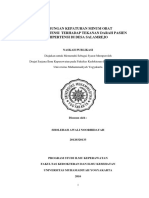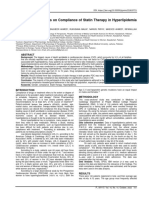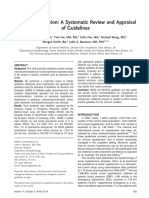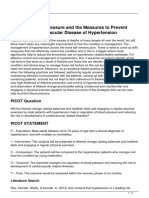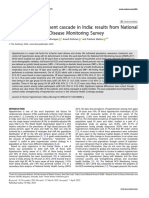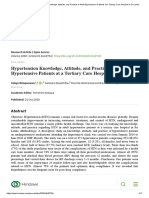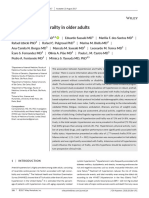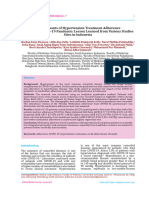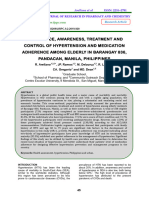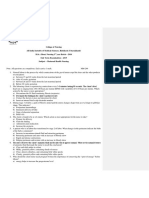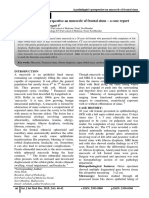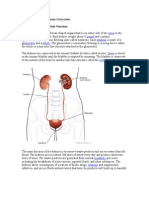MJMHS 0513
MJMHS 0513
Uploaded by
aisha.alhamadi99Copyright:
Available Formats
MJMHS 0513
MJMHS 0513
Uploaded by
aisha.alhamadi99Original Description:
Original Title
Copyright
Available Formats
Share this document
Did you find this document useful?
Is this content inappropriate?
Copyright:
Available Formats
MJMHS 0513
MJMHS 0513
Uploaded by
aisha.alhamadi99Copyright:
Available Formats
Malaysian Journal of Medicine and Health Sciences (eISSN 2636-9346)
ORIGINAL ARTICLE
Predictors of Uncontrolled Hypertension among Patients
Receiving Treatment from Public Primary Care Clinics in Pulau
Pinang, Malaysia
Tan Hooi Shyuan1,2, Ahmad Azuhairi Ariffin1, Nor Afiah Mohd Zulkefli1, Feisul Idzwan Mustapha3 ³
1
Department of Community Health, Faculty of Medicine and Health Sciences, Universiti Putra Malaysia, Serdang, Selangor,
Malaysia
2
Ministry of Health
3
Ministry of Health Malaysia Disease Control Division, Wilayah Persekutuan, 62000 Putrajaya, Malaysia
ABSTRACT
Introduction: Hypertension treatment aims to reduce morbidity and mortality from cardiovascular and renal com-
plications. In Malaysia, there is a high prevalence of uncontrolled hypertension among patients on treatment. This
study aimed to identify the predictors of uncontrolled hypertension among patients receiving treatment from public
primary care clinics in Pulau Pinang, Malaysia. Methods: An unmatched case-control study with 1:1 ratio was con-
ducted among 334 hypertensive patients receiving treatment from selected public primary care clinics. Mean blood
pressure measurements from the last two clinical visits were used to determine the hypertension status, and uncon-
trolled hypertension was defined as 140/90 mm Hg or higher. The cases were those with uncontrolled hypertension,
while the controls were those with controlled hypertension. Participants were recruited by simple random sampling.
Independent variables were sociodemographic factors, clinical and psychosocial factors, medication adherence,
lifestyle modification, and clinical inertia. Data were collected using validated questionnaires and review of medi-
cal records. Multiple logistic regression analysis was performed by using IBM SPSS Statistics 25. Results: The mean
age of respondents was 59 years (SD=11). Patients with medication non-adherence had 11.36 times higher odds of
uncontrolled hypertension (aOR=11.36, 95% CI=6.59, 19.56, p<0.001). Clinical inertia increased 7.82 times the
odds of uncontrolled hypertension (aOR=7.82, 95% CI=2.65, 23.09, p<0.001). Conclusion: Addressing medication
adherence and clinical inertia are vital in reducing uncontrolled hypertension. The findings would help to prioritise
interventions to improve the clinical management of hypertension and patient outcomes.
Keywords: Hypertension, Case-control studies, Medication adherence, Malaysia
Corresponding Author: Hypertension control is generally defined as the
Ahmad Azuhairi Ariffin, MCMed (OH) reading of blood pressure of less than 140/90 mm Hg in
Email: zuhairifin@upm.edu.my uncomplicated cases (6). Despite of having an effective
Tel: +603-97692424 treatment, only 37.1% of people worldwide achieve
targeted blood pressure control with medication. The
INTRODUCTION proportion was two times higher in high-income countries
compared to low- and middle-income countries, with
Hypertension is a major public health concern. It is the 50.4% and 26.3% respectively (2). To highlight the
leading preventable risk factor for premature death and issue, the World Health Organization recommends to
disability worldwide, primarily due to cardiovascular include the percentage of people whose hypertension is
diseases and stroke (1). Globally, it was estimated that controlled by medication as part of the tracer indicator in
31.1% of adults had hypertension in 2010 (2). Malaysia, monitoring essential health coverage for cardiovascular
which is an upper-middle income country, shares a disease prevention within the Sustainable Development
similar scenario with the global statistics. Ischaemic heart Goals (7). In Malaysia, 81.2% of known hypertension
disease and stroke are the leading causes of premature patients are on treatment and 76% of treated patients
death in the country, with 30.3% of Malaysian adults are being managed in public healthcare facilities (3)
or 6 million people are living with hypertension (3,4). that are highly subsidised with good availability of anti-
Hypertension must be adequately treated to a certain hypertensive agents. However, blood pressure control
blood pressure goal to reduce vascular morbidity and among hypertensive patients on treatment remains sub-
mortality (5). optimal in the country, with the percentage reported in a
Mal J Med Health Sci 16(4): 234-243, Dec 2020 234
Malaysian Journal of Medicine and Health Sciences (eISSN 2636-9346)
few studies ranging from 26.6% to 31% (8–10). complex medication regimens (22).
Literature suggests that multiple factors are The sampling frame was obtained from the list of
associated with hypertension control. With regards to hypertensive patients from the clinic appointment
sociodemographic factors, the associations between system. The mean documented blood pressure readings
age, gender, ethnicity and hypertension control from from the last two clinic visits was used to determine
previous studies are inconsistent (2,9–12). Higher the hypertension status. Cases were defined as patients
educational level is associated with better hypertension with uncontrolled hypertension (≥140/90 mm Hg) and
control (9,10). As for clinical factors, an increased controls were patients with controlled hypertension
number of anti-hypertensive agents is associated with (<140/90 mm Hg). The Schlesselman case control study
uncontrolled hypertension (13,14). Stress has been formula was used to calculate the sample size (23) and
associated with medication non-adherence (15), the proportion values were obtained from the local
although little is known about the association between study on hypertension control (21). A minimum sample
stress, depression, anxiety and hypertension control. size of 163 per group was required, assuming a type-1
A number of studies reported a significant association error of 5% (α = 0.05) and a power of 80%. Given a 20%
between medication adherence and hypertension possible non-response rate, the final sample size was
control (16–18). In terms of lifestyle modification, 205 per group. As 1:1 ratio was used for the number of
high dietary salt intake is associated with uncontrolled cases and controls, a total of 410 patients were selected
hypertension (19). However, the association between from the appointment list by simple random sampling
smoking and hypertension control is inconsistent method using the random number generator in Excel.
(10,12,14), with scarce data on the association between
physical activity, alcohol consumption and hypertension Instruments
control. Despite the existence of guidelines on the Two study instruments were used, a proforma to
management of hypertension, the clinical inertia or extract data from the patient's medical record and a
lack of active management, is known to be associated questionnaire. The proforma included age, gender,
with uncontrolled hypertension (20). A few studies ethnicity, blood pressure readings, body mass index,
found that adherence to the guideline and appropriate number and frequency of anti-hypertensive agents used,
intensification of treatment were associated with and clinical inertia assessment. Clinical inertia was
controlled hypertension (11,21). present when no active management was performed
as recommended in the Malaysian Clinical Practice
Most of the previous studies on hypertension control in Guideline on Hypertension (24) when the patient had
Malaysia were cross-sectional studies, in which the study uncontrolled blood pressure during any follow-up visits
design was mainly used to determine the prevalence. In in the past one year without a documented reason or
this paper we describe the use of a case-control study refusal by the patient. Active management included
to identify the predictors of uncontrolled hypertension increasing the dose of the anti-hypertensive agent;
among hypertensive patients receiving treatment replacing the initial anti-hypertensive agent with another
from public primary care clinics in a district of Pulau class; adding another anti-hypertensive agent; assessing
Pinang, Malaysia. The findings would help to prioritise patient adherence to the medication; or advising on
interventions to improve the clinical management of lifestyle modification.
hypertension and patient outcomes.
The questionnaire consisted of seven sections. The
MATERIALS AND METHODS first section was on additional sociodemographic and
clinical data, including education level, living status,
Study design, setting and sample selection and hypertension duration. The second section was
A clinic-based unmatched case-control study was medication adherence assessment. As the Malay
conducted in all five public primary care clinics in the version of the Hill-Bone Compliance to High Blood
Seberang Perai Tengah District, Pulau Pinang, Malaysia Pressure Therapy Scale developed and tested for use in
from November 2018 to April 2019. The study population Malaysian primary healthcare settings did not conform
was hypertensive patients aged 18 to 80 years old who to the structural, predictive validity and reliability of the
received at least one year of treatment from any of the original scale, thereby limiting its use in current study
clinics. The study excluded patients who had defaulted (25). With reference to the study findings, the medication
appointments during the study period or their last adherence scale used in the current study removed
visit to clinic more than six months from the sampling items with poor correlation with remaining items and
date, and those with diabetes mellitus, ischaemic heart added two important items from other scales to reflect
disease, cerebrovascular disease or renal impairment. the non-adherence concept in Malaysia (16,26). The
Hypertensive patients with other major diseases were current eight items questionnaire used a four-point
excluded because they had different blood pressure scale to indicate the frequency of medication taking
targets. In addition, they may not able to recognise the behaviour over the past six months, 1=never, 2=rarely
exact effect of anti-hypertensive medication due to their (once monthly or less), 3=sometimes (two to three times
235 Mal J Med Health Sci 16(4): 234-243, Dec 2020
a month) and 4=often (once weekly or more). The cut- adherence, and explained 38.4% and 17.5% of the
off value was determined by the Receiver Operating variance, respectively. The eight-item medication
Characteristic (ROC) curve, a total score of eight was adherence scale showed good internal consistency with
classified as adherence, while a score of nine and above the Cronbach's alpha value of 0.70. With respect to the
was classified as non-adherence. dietary salt Intake Scale, the exploratory factor analysis
revealed a single component that explained 50.9% of
The third section was dietary salt intake assessment with the variance and the Cronbach's alpha value was 0.66.
four items adapted from the reducing sodium intake
behaviour subscale of Hill-Bone High Blood Pressure Data collection procedure
Therapy Compliance Scale and Malaysian MySalt study The informed consent of the participants was obtained
findings (27,28). The questionnaire used a four-point prior to the data collection. The interviewer-assisted
scale to indicate the frequency of high dietary salt intake method was used because a large proportion of
over the past one week, 1=never, 2=rarely (two days or participants were in the older age group, some of
less), 3=sometimes (three to five days) and 4=often (six whom had poor vision or reading skills. The principal
days or more). The dietary salt intake was categorised investigator, who was not the treating physician, was the
as low (score five and below), moderate (score six to only interviewer in the data collection process, thereby
eight) and high (score nine and above) based on the avoiding inter-interviewer bias. The questions were read
ROC curve. as written and in the exact order so that the results are
comparable. Responses were recorded by either the
The fourth section was physical activity level participant or the interviewer. Additional information
measured by the validated International Physical or comments from the participants were noted, which
Activity Questionnaire (IPAQ) with seven items and served as valuable information during interpretation
was classified as low, moderate and high (29). The of the results. Before the end of the session, the
fifth section was smoking behaviour assessed by eight questionnaire was checked for completeness. This
items adapted from the Malaysian National Health and included obtaining data directly from the participants if
Morbidity Survey and categorised as current smoker, the data were missing in the proforma due to incomplete
former smoker and never smoker (3). The sixth section documentation in the medical records. The average
was alcohol consumption measured by three items response time needed was 15 minutes.
adapted from Alcohol Use Disorders Identification Test
(30). It assessed alcohol consumption over the past Ethical consideration
one year and categorised into current drinker and non- The ethical approval of the study was obtained from the
drinker. The final section assessed psychosocial factors Medical Research and Ethics Committee (MREC) of the
by using the validated 21-item Depression, Anxiety and Ministry of Health of Malaysia on 25 October 2018 with
Stress Scale (DASS) and was categorised as normal and reference number NMRR-18-2592-42309.
abnormal score (31).
Data analysis
Validity and reliability Statistical analysis was performed by using IBM SPSS 25
The questionnaire was validated using both content and for Windows software package. Descriptive analysis was
face validation. The panel of six specialists in the field done to show the distribution of variables. Categorical
of public health and family medicine independently variables were presented in frequency and percentages,
assessed the validity of content on representativeness while continuous variables were presented in mean and
and clarity. The representativeness referred to the standard deviations. The Chi-square and Independent
ability of each item to represent the study variable, T-tests were used to compare the variables between
while the clarity indicated the clear wording of each the cases and the controls. Simple logistic regression
item (32). Corrections were made based on the ratings analysis was performed to show the association between
and additional recommendations. The face validity of variables and uncontrolled hypertension. Subsequently,
the questionnaire was conducted among hypertensive variables with p value < 0.25 from simple logistic
patients receiving treatment from a primary care clinic regression were selected for multiple logistic regression
outside the study sites. The questionnaire was refined to determine the predictors of uncontrolled hypertension
based on their feedbacks, which were predominantly (33). Three methods of variable selection including
about the clarity and words used. forward selection, backward elimination, and enter
method were used to select the most fit model. A two-
Construct validity and reliability tests were carried out sided p value of < 0.05 and a 95% confidence interval
on the medication adherence scale and dietary salt which did not include a null value were considered
intake scale, which have been adapted from several statistically significant.
questionnaires. The exploratory factor analysis revealed
a two-component structure within the medication RESULTS
adherence scale. The two components represented
intentional non-adherence and unintentional non- Of the total 410 patients recruited, there were 334
Mal J Med Health Sci 16(4): 234-243, Dec 2020 236
Malaysian Journal of Medicine and Health Sciences (eISSN 2636-9346)
patients agreed to participate, making the response Table II: Clinical factors, psychosocial factors, medication adherence
rate 81.5%. The main reason for non-response was the and lifestyle modification of participants
refusal to participate due to time constraints, as either Cases Controls
Variables (n=167) (n=167) χ2 test (df) p value
they or their caregivers had to go to work after the n (%) n (%)
follow-up visits. Participants age ranged from 21 to 79 Duration of hypertension (years) 0.221 (2) 0.896
years (mean=59.4, SD=11.4). Both groups had a higher <5 75 (44.9) 73 (43.7)
percentage of females, Malay ethnicity, secondary
5-10 59 (35.3) 63 (37.7)
education, and stayed with the family (Table I). Among
>10 33 (19.8) 31 (18.6)
the cases, 55.1% had hypertension for more than 5 years,
Number of AHA types used
1
4.841 (1) 0.028*
61.1% had two or more anti-hypertensive agents and
93.4% had once daily medication regimens (Table II). One 65 (38.9) 85 (50.9)
While 56.7% of the controls had hypertension for more Two or more 102 (61.1) 82 (49.1)
than 5 years, 49.1% had two or more anti-hypertensive Daily dose frequency of AHA 1
1.007 (1) 0.316
agents and 90.4% had once daily medication regimens. Once 156 (93.4) 151 (90.4)
Twice or more 11 (6.6) 16 (9.6)
Table I: Sociodemographic characteristics of participants
Body Mass Index 3.748 (2) 0.154
Cases (n=167) Controls
Variables n (%) (n=167) χ test (df)
2
p value Normal 30 (18.0) 37 (22.2)
n (%)
Overweight 66 (39.5) 76 (45.5)
Age (years) 59.8 (11.2)1 59.0 (11.5)1 0.682 0.496
Obese 71 (42.5) 54 (32.3)
(332)2
Depression 0.320 (1) 0.572
Gender 0.199 (1) 0.655
Abnormal score 14 (8.4) 17 (10.2)
Male 65 (38.9) 69 (41.3)
Normal score 153 (91.6) 150 (89.8)
Female 102 (61.1) 98 (58.7)
Anxiety 3.662 (1) 0.056
Ethnicity 1.469 (2) 0.480
Abnormal score 20 (12.0) 10 (6.0)
Malay 91 (54.5) 85 (50.9)
Normal score 147 (88.0) 157 (94.0)
Chinese 60 (35.9) 59 (35.3)
Stress 0.420 (1) 0.517
Indian 16 (9.6) 23 (13.8)
Abnormal score 10 (6.0) 13 (7.8)
Educational Level 0.866 (4) 0.929
Normal score 157 (94) 154 (92.2)
No formal 6 (3.6) 7 (4.2)
education Dietary salt intake 2.724 (2) 0.256
Primary 52 (31.1) 47 (28.1) Low 52 (31.1) 61 (36.5)
Secondary 84 (50.3) 91 (54.5) Moderate 72 (43.1) 75 (44.9)
Pre-university 10 (6.0) 8 (4.8) High 43 (25.7) 31 (18.6)
Tertiary 15 (9.0) 14 (8.4) Physical activity level 0.487 (2) 0.784
Living status 0.363 (1) 0.547 Low 71 (42.5) 77 (46.1)
Staying with 152 (91.0) 155 (92.8) Moderate 81(48.5) 77 (46.1)
family
High 15 (9.0) 13(7.8)
Staying alone or 15 (9.0) 12 (7.2)
in care insti- Smoking status 2.173 (2) 0.337
tution Current smoker 20 (12.0) 22 (13.2)
1
mean (SD) 2
t(df)
Former smoker 15 (9.0) 23 (13.8)
The prevalence of overweight and obesity among Never smoker 132 (79.0) 122 (73.0)
participants was high with 82% of cases and 77.8% of Alcohol Consumption 1.099 (1) 0.295
controls (Table II). The percentage of DASS abnormal Current drinker 30 (18.0) 23 (13.8)
scores for depression, anxiety and stress ranged from
Non-drinker 137 (82.0) 144 (86.2)
6.0% to 12.0% for cases, and 6.0% to 10.2% for
Medication adherence 94.536 (1) <0.001*
controls. High dietary salt intake was reported in 25.7%
Adherence 28 (16.8) 116 (69.5)
of cases and 18.6% of controls. The prevalence of low
level of physical activity was high with 42.5% of cases Non-adherence 139 (83.2) 51 (30.5)
and 46.1% of controls. There were 12.0% of cases and Number of follow- 4.2 (1.2)2 3.8 (1.1)2
up visits per year
13.2% of controls were current smokers, while 18.0%
Clinical inertia 22.157 (1) <0.001*
of cases and 13.8% of controls consumed alcohol. It
was found that 83.2% of cases were non-adherent to Presence 32 (19.2) 5 (3.0)
medication as compared to 30.5% of controls. The Absence 135 (80.8) 162 (97.0)
*p < 0.05 level (2-tailed)
mean number of follow-up visits per year for cases was 1
AHA: Anti-hypertensive agents
4.2 (SD=1.2) and 3.8 (SD=1.1) for controls. Clinical 2
mean (SD)
237 Mal J Med Health Sci 16(4): 234-243, Dec 2020
inertia was found in 19.2% of cases and 3% of controls. Table IV: Association of uncontrolled hypertension with clinical fac-
tors, psychosocial factors, medication adherence and clinical inertia
by simple logistic regression analysis
Simple logistic regression analysis found that those with
Regression
two or more antihypertensive agents increased the odds Variables coefficient
Crude odd ratio Wald
p value
(95% CI) statistic
of uncontrolled hypertension by 1.6 times as compared (b)
to those with one antihypertensive agent (OR=1.63, 95% Duration of hypertension (years)
CI=1.05, 2.51, p=0.028). Non-adherence to medication <5 0 1
increased the odds of uncontrolled hypertension by
5-10 -0.09 0.91 (0.56, 1.47) 0.14 0.705
11.29 times (OR=11.29, 95% CI=6.69, 19.05, p<0.001),
>10 0.04 1.04 (0.58, 1.86) 0.01 0.906
and clinical inertia increased the odds of uncontrolled
Number of AHA types used
1
hypertension by 7.68 times (OR=7.68, 95% CI=2.91,
20.26, p<0.001). Other variables showed no significant One 0 1
results, including sociodemographic factors, duration of Two or more 0.49 1.63 (1.05, 2.51) 4.82 0.028*
hypertension, body mass index, daily dose frequency Daily dose frequency of AHA 1
of medication, psychosocial factors, and lifestyle Once 0.41 1.50 (0.68, 3.34) 1.00 0.318
modification (Table III & IV). Twice or more 0 1
Table III: Association of uncontrolled hypertension with sociodemo- Body Mass Index
graphic factors by simple logistic regression analysis
Normal 0 1
Regression Crude odd
Wald Overweight 0.07 0.82 (0.60, 1.92) 0.05 0.818
Variables coefficient ratio p value
statistic
(b) (95% CI) Obese 0.48 0.11 (0.89, 2.95) 2.51 0.113
Age (years) 0.01 1.01 0.47 0.494 Depression
(0.99, 1.03)
Abnormal score -0.21 0.81 (0.38, 1.70) 0.32 0.572
Gender
Normal score 0 1
Male 0 1
Anxiety
Female 0.10 1.11 0.20 0.655
(0.71, 1.71) Abnormal score 0.76 2.14 (0.97, 4.72) 3.53 0.060
Ethnicity Normal score 0 1
Malay 0.43 1.54 1.44 0.230 Stress
(0.76, 3.11)
Abnormal score -0.28 0.76 (0.32, 1.77) 0.42 0.518
Chinese 0.38 1.46 1.03 0.309
Normal score 0 1
(0.70, 3.04)
Dietary salt intake
Indian 0 1
Low 0 1
Educational Level
Moderate 0.12 1.13 (0.69, 1.84) 0.23 0.636
No formal education -0.22 0.80 0.11 0.739
(0.22, 2.97) High 0.49 1.63 (0.90, 2.94) 2.60 0.107
Primary 0.03 1.03 0.01 0.939 Physical activity
(0.45, 2.36) level
Secondary -0.15 0.86 0.14 0.710 Low -0.22 0.80 (0.36, 1.80) 0.30 0.587
(0.39, 1.89)
Moderate -0.09 0.91 (0.41, 2.04) 0.05 0.822
Pre-university 0.15 1.17 0.07 0.798
(0.36, 3.80) High 0 1
Tertiary 0 1 Smoking status
Living status Current smoker -0.17 0.84 (0.43, 1.62) 0.27 0.602
With family 0 1 Former smoker -0.51 0.60 (0.30, 1.21) 2.04 0.154
Alone or in care 0.24 1.28 0.36 0.548 Never smoker 0 1
institution (0.58, 2.81)
Alcohol Con-
*p < 0.05 level (2-tailed) sumption
Current drinker 0.32 1.37 (0.76, 2.48) 1.09 0.296
From the simple logistic regression analysis, variables Non-drinker 0 1
with p value < 0.25 were included for multiple logistic Medication adherence
regression (33). Eight variables were selected, including Adherence 0 1
ethnicity, body mass index, anxiety, number of anti- Non-adherence 2.42 11.29 (6.69, 82.60 <0.001**
hypertensive agent types used, medication adherence, 19.05)
dietary salt intake, smoking status, and clinical inertia. Clinical inertia
The forward selection with likelihood ratio method Presence 2.04 7.68 (2.91, 20.26) 16.98 <0.001**
appeared to be the most fit model. There was no Absence 0 1
multicollinearity, with a small correlation between the *p < 0.05 level (2-tailed), ** p <0.001 level (2-tailed)
1
AHA: Anti-hypertensive agents
Mal J Med Health Sci 16(4): 234-243, Dec 2020 238
Malaysian Journal of Medicine and Health Sciences (eISSN 2636-9346)
variables (r =0.13) and a variance inflation factor of less Medication non-adherence is a predictor of uncontrolled
than 10. No significant interaction effect was noted in hypertension consistent with the results of previous
the model (p=0.585). studies (16–18). Medication non-adherence is the
main reason why treatment that has been shown to be
Only two variables, namely medication adherence efficacious in randomised clinical trials is often less
and clinical inertia, were found to be significant in the effective in real clinical practice (34). It has been widely
final model. Hypertensive patients with medication described as either intentional or unintentional because
non-adherence had 11.36 times the odds of having of the different factors associated with each and the need
uncontrolled hypertension (aOR=11.36, 95% CI=6.59, for different tailored solutions (25,34–36). Intentional
19.56, p<0.001) when adjusted for clinical inertia. It non-adherence refers to a process in which the patient
also showed that hypertensive patients experienced consciously decides not to use the medication or not
clinical inertia had 7.82 times the odds of having to follow the prescribed regimen. Unintentional non-
uncontrolled hypertension (aOR=7.82, 95% CI=2.65, adherence, on the other hand, is an unplanned passive
23.09, p<0.001) when adjusted for medication non- process and involves factors beyond the control of the
adherence (Table V). The model explained 40% of the patient (34,35). The medication adherence scale used in
variance in uncontrolled hypertension (Nagelkerke R current study is able to assess these two components of
square= 0.40) and was able to correctly classify 76.6% non-adherence behaviour.
(95% CI=71.73, 81.08) of the subjects. The Hosmer-
Lemeshow Goodness-of-Fit Test showed a good fit of There are four items that imply unintentional non-
the model (p=0.859). adherence, including forgetfulness, skipped as running
out of medication, skipped as forgotten to bring along
Table V: Predictors of uncontrolled hypertension by multiple logistic
regression model when away from home, and skipped before going to
Adjusted Wald
see their physician. Forgetfulness was the most common
Regression Standard
Variables coefficient error
odd ratio statistic
p value
reason of non-adherence among participants in current
(95% study, which could be due to difficulties in making it a
(b) (SE)
CI) a
habit, as reported in a systematic review of qualitative
Medication adherence
and quantitative studies on barriers to hypertension
Adherence 0 1 <0.001**
therapy (37). Intervention to improve medication self-
Non-adher- 2.43 0.28 11.36 76.66 management skills is needed to help patients remember
ence (6.59,
19.56) to take medication by integrating it into their daily routine
Clinical inertia (35). Patients may benefit from the use of pill boxes to
Presence 2.06 0.55 7.82 13.87 <0.001**
organise their medication by day of the week and timing
(2.65, for each pill, or using calendars or telephone reminders
23.09) to help them remember to take their medication at the
Absence 0 1 right time (38). Healthcare providers may also help to
Constant -1.61 remind patients of timely medication refills by sending
** p <0.001 level (2-tailed)
a
Forward likelihood ratio multiple regression model was applied
text messages to their mobile phones (34).
The other four items in the medication adherence scale
DISCUSSION involve the intentional non-adherence, including not
taking medication by decision, skipping when feeling
The current study aimed to identify predictors of better, skipping when feeling sick, and changing the
uncontrolled hypertension among patients on treatment dose of medication. One of the common reasons for
in response to high prevalence of uncontrolled the intentional non-adherence is misperception of
hypertension in Malaysia. Sociodemographic factors, hypertension and its medication (22,39). Previous studies
including age, gender, ethnicity, educational level and found that patients stopped their anti-hypertensive agents
living status, have not been found to be significantly because they perceived hypertension as a temporary and
associated with uncontrolled hypertension. The results curable condition but not a life-long illness (22,36,40,41)
showed that the case and control groups shared or believed that they did not need medication because
similar sociodemographic characteristics. Among the they had no symptoms (37). Experienced side effects of
variables investigated, medication non-adherence and anti-hypertensive agents have also been shown to be a
clinical inertia were found to be significant predictors common reason of non-adherence (36,40). Educational
of uncontrolled hypertension by using multiple logistic intervention to improve adherence to medication should
regression. Despite the lack of precision in odds ratio therefore address patients' perceptions of hypertension
due to the small sample size of hypertensive patients and medication rather than simply focusing on the
with medication non-adherence and clinical inertia provision of knowledge.
indicated by a wide confidence interval, the findings are
useful to provide insight into uncontrolled hypertension. In the current study, clinical inertia was found to be the
239 Mal J Med Health Sci 16(4): 234-243, Dec 2020
significant predictor of uncontrolled hypertension. The modification, including dietary diet intake, physical
different operational definitions and methodologies used activity, smoking, and alcohol consumption. The results
to report clinical inertia in previous studies have made are consistent with a community-based study in Nepal
comparisons difficult. Philips et al. first introduced the that found no statistically significant association between
term clinical inertia in 2001, which was defined as the hypertension control and healthy behaviours (45).
failure of physicians to initiate or intensify therapy when The descriptive analysis of this study showed a similar
appropriate (42). This study recognised the assessment proportion of cases and controls with high dietary salt
of medication adherence and lifestyle modification intake (25.7% versus 18.6%) and low level of physical
advice as active management of hypertension care, activity (42.5% versus 46.1%). Despite studies showing
in addition to the intensification of pharmacological benefits of lowering blood pressure with reduced dietary
therapy. Another extension of the definition of clinical salt intake and increased physical activity (46–48), this
inertia in the current study is to take into account study showed widespread non-compliance with lifestyle
the refusal of patients to step up therapy and the modification among the participants, regardless of their
documented justifications. Previous literature suggested status of hypertension control. As reported in a qualitative
that uncertainty about the true value of blood pressure, study, most of the hypertensive patients were reluctant
such as when the patient reported home blood pressure to make major disruptive lifestyle changes. They found
readings meeting the target, was a common reason why it easier to take medication than to change their diet,
therapy remained unchanged (43). to stop smoking, or to be more physically active in
controlling their blood pressure (40). Moreover, it is
Despite some minor differences in the definition of widely believed that the change in diet is particularly
clinical inertia in previous studies, this result is consistent difficult to embrace with abundant and easily accessible
with the previous findings. A study in Florida found that Malaysian foods that are high in oil, salt and sugar (41).
66% of all newly diagnosed hypertensive patients had
clinical inertia at least once during the study period. The implications of this study includes enhancing the
Clinical inertia reported in the study was associated understanding of uncontrolled hypertension among
with almost 3 times the odds of uncontrolled blood patients receiving treatment from public primary care
pressure in hypertensive patients (20). In Malaysia, clinics that could be used to inform policy, practice and
a few studies focused on the adherence of physicians intervention. The findings have shown that a combination
to the clinical practice guideline in prescribing the of different approaches is needed to improve the control
first-line anti-hypertensive agent. A cross-sectional of hypertension. One of the important implications is
study with prescription data and medical records in that both the medication adherence and clinical inertia
a tertiary hospital found that adherence to guideline should be taken into account when designing the
was a significant predictor that increased the odds of intervention for this purpose.
controlled hypertension by 1.7 times (21). Another
study conducted at health clinics in Kedah, Malaysia, It is recommended that the medication adherence
found that hypertensive patients receiving appropriate assessment for all hypertensive patients with a short and
intensification of treatment were 2 times more likely to validated questionnaire to be included in the clinical
have controlled hypertension (11). practice guideline. Proactive screening of medication
adherence and related issues could serve as the initial
The current study was unable to detect the association step towards improving adherence and subsequently
between body mass index and uncontrolled the control of hypertension. Interventions to enhance
hypertension. From the descriptive analysis, the majority medication adherence should be tailored to the needs
of hypertensive patients were either overweight or of the patient on the basis of either unintentional or
obese, accounting for 82% of cases and 78% of controls. intentional non-adherence or both. It is important to
The result is consistent with the REDISCOVER study in develop patient self-management skills so that they can
Malaysia, that found no significant association between remember to take and handle their medications better by
body mass index and hypertension control (10). There incorporating them into their daily routine. Educational
was no significant association between psychosocial intervention should address patients' perceptions of
factors, which were stress, anxiety and depression, hypertension and medications in order to reduce the
and uncontrolled hypertension. A systematic review intentional non-adherence. In addition, the evaluation
of psychosocial risk factors for hypertension including of clinical inertia is recommended as part of the quality
21 cohort or case-control studies, found inconsistent control and performance monitoring programme in
association between mental health and hypertension public primary care clinics. Interventions to overcome
(44). However, the comparison of findings was clinical inertia should focus on the contributing factors
complicated by the different assessment tools used in involving patients, providers and the healthcare system,
previous studies to measure the state of mental health. which ultimately aim at improving the control of
hypertension.
The current study found no significant association
between uncontrolled hypertension and lifestyle One of the strengths of this study is to have two equal
Mal J Med Health Sci 16(4): 234-243, Dec 2020 240
Malaysian Journal of Medicine and Health Sciences (eISSN 2636-9346)
groups by using a case-control approach to maximise clinical practice, including addressing the barriers that
the power to detect a significant difference. The case- patients may encounter in their efforts to maintain blood
control approach has also made it possible to identify pressure and optimal health.
the predictors of uncontrolled hypertension with its
relative importance by calculating the odds ratio, which CONCLUSION
could help to prioritise the specific management plan
and the counselling content of each follow-up visit for The study findings suggest that priority should be given
better patient outcomes. to improving medication adherence and reducing
clinical inertia in the management of uncontrolled
The interviewer-assisted method used to collect hypertension. A routine assessment of medication
data from participants improved the response rate adherence is recommended during follow-up visits by
and data quality. The possibility of missing data and using a short and validated questionnaire. In addition,
misinterpretation of the questions being asked has the evaluation of clinical inertia should be included
been minimised. However, this method may be subject in the hypertension quality assurance programme
to socially desirable response bias, particularly in the in public primary care clinics. Despite the lack of a
assessment of medication adherence. In order to reduce significant relationship between lifestyle modification
the bias, the interviewer asked questions in a non- and uncontrolled hypertension, the clinical significance
judgmental manner and normalised non-adherence by of lifestyle modification cannot be denied. In fact, these
recognising the difficulties of adhering to medication. statistically insignificant results indicated that most
hypertensive patients, regardless of their hypertension
The use of the questionnaire is limited by recall bias. The status, were reluctant to make major lifestyle changes.
medication adherence scale has the longest recall period Therefore, more effort is needed to encourage lifestyle
of six months, although this has been done with the aim modification, in view of the enormous health benefits
of optimising response options. Since the hypertension that it could offer in addition to hypertension control.
control in this study was determined by mean blood
pressure readings during the last two visits, an average ACKNOWLEDGEMENTS
of three to four months apart, a longer recall period
was required to establish a meaningful association. In The authors would like to thank the Director General of
addition, the different time frames for recall periods Health Malaysia for his permission to publish this paper.
used in the respective sections of the questionnaire may The authors are very grateful to all participants in the
appear unclear to participants and therefore require study for giving their time and information. A special
further emphasis and clarification from the interviewer. thanks to all health care providers at study sites for their
Due to this limitation, it is recommended that the support during data collection.
questionnaire in this study to be used as an interviewer-
assisted measure rather than a self-reported measure. REFERENCES
Due to limited time and resources, the current study 1. Global Burden of Disease 2016 Risk Factors
did not examine the association of health system factors Collaborators. Global, regional, and national
with uncontrolled hypertension. Finally, as the study comparative risk assessment of 84 behavioural,
involved only public primary care clinics in a district environmental and occupational, and metabolic
of Pulau Pinang, Malaysia, the generalisability of these risks or clusters of risks, 1990–2016: a systematic
findings is therefore limited. analysis for the Global Burden of Disease Study
2016. Lancet. 2017;390(10100):1345–422.
For future studies, a qualitative approach is https://www.thelancet.com/journals/lancet/article/
recommended to explore the perceptions and PIIS0140-6736(17)32366-8/fulltext
experiences of patients and healthcare providers in the 2. Mills KT, Bundy JD, Kelly TN, Reed JE, Kearney
management of uncontrolled hypertension, as in-depth PM, Reynolds K, et al. Global disparities of
findings can help to enhance the contents of a tailored hypertension prevalence and control: A systematic
intervention programme. Patients and healthcare analysis of population-based studies from 90
providers may have different perspectives on certain countries. Circulation. 2016;134(6):441–50.
health issues which could be seen as complementary, 3. Institute for Public Health. National Health and
so that a mutually acceptable strategy for hypertension Morbidity Survey 2015 Vol. II: Non-communicable
care improvement can be put in place. Moreover, it is diseases, risk factors & other health problems.
valuable to explore the factors of clinical inertia among Kuala Lumpur: Ministry of Health Malaysia; 2015.
healthcare providers, as they traditionally play a more 4. Yusoff UN, Mahat D, Omar A, Teh HC. Burden of
dominant role in clinical management and influence Premature Mortality in Malaysia. Int J Public Heal
the patient-provider relationships. Future studies are Res. 2013;3(1):249–56. http://spaj.ukm.my/ijphr/
also recommended to critically examine knowledge index.php/ijphr/article/view/157
on what we have already known but do not apply in 5. Ettehad D, Emdin CA, Kiran A, Anderson SG,
241 Mal J Med Health Sci 16(4): 234-243, Dec 2020
Callender T, Emberson J, et al. Blood pressure medication adherence. Int J Ment Health Syst.
lowering for prevention of cardiovascular disease 2014;8(1):4–9.
and death : a systematic review and meta-analysis. 16. Ramli A, Ahmad NS, Paraidathathu T. Medication
Lancet. 2016;387(10022):957–67. http://dx.doi. adherence among hypertensive patients of
org/10.1016/S0140-6736(15)01225-8 primary health clinics in Malaysia. Patient Prefer
6. Ministry of Health Malaysia, Malaysian Society of Adherence. 2012;6:613–22.
Hypertension, Academy of Medicine of Malaysia. 17. Yassine M, Al-Hajje A, Awada S, Rachidi S, Zein
Clinical practice guidelines management of S, Bawab W, et al. Evaluation of medication
hypertension 5th Edition. 2018. http://www. adherence in Lebanese hypertensive patients. J
acadmed.org.my/view_file.cfm?fileid=894 Epidemiol Glob Health. 2016;6(3):157–67. http://
7. Hogan DR, Stevens GA, Hosseinpoor AR, Boerma dx.doi.org/10.1016/j.jegh.2015.07.002
T. Monitoring universal health coverage within the 18. Khayyat SM, Khayyat SMS, Hyat Alhazmi RS,
Sustainable Development Goals: Development Mohamed MMA, Abdul Hadi M. Predictors of
and baseline data for an index of essential health medication adherence and blood pressure control
services. Lancet Glob Heal. 2018;6:e152–68. http:// among Saudi hypertensive patients attending
dx.doi.org/10.1016/S2214-109X(17)30472-2 primary care clinics: A cross-sectional study.
8. Rampal L, Rampal S, Azhar MZ, Rahman AR. PLoS One. 2017;12(1):e0171255. http://dx.plos.
Prevalence, awareness, treatment and control org/10.1371/journal.pone.0171255
of hypertension in Malaysia: A national study of 19. Suzana S, Azlinda A, Hin SL, Khor WH, Zahara
16,440 subjects. Public Health. 2008;122(1):11–8. Z, Sa’ida Munira J, et al. Influence of food
9. Chow CK, Teo KK, Rangarajan S, Islam S, Gupta R, intake and eating habits on hypertension control
Avezum A, et al. Prevalence, awareness, treatment, among outpatients at a government health clinic
and control of hypertension in rural and urban in the Klang Valley, Malaysia. Malays J Nutr.
communities in high-, middle-, and low-income 2011;17(2):163–73.
countries. Jama. 2013;310(9):959–68. http://jama. 20. Harle CA, Harman JS, Yang S. Physician and
jamanetwork.com/article.aspx?doi=10.1001/ patient characteristics associated with clinical
jama.2013.184182 inertia in blood pressure control. J Clin Hypertens.
10. Abdul-Razak S, Daher AM, Ramli AS, Ariffin 2013;15(11):820–4.
F, Mazapuspavina MY, Ambigga KS, et al. 21. Ahmad N, Hassan Y, Tangiisuran B, Meng OL,
Prevalence, awareness, treatment, control and Aziz NA, Ahmad FUD, et al. Guidelines adherence
socio demographic determinants of hypertension and hypertension control at a tertiary hospital in
in Malaysian adults. BMC Public Health. Malaysia. J Eval Clin Pract. 2013;19(5):798–804.
2016;16(351):1–10. 22. Lee K, Halimatun HM, Steven EK, Ong BK.
11. Teoh SH, Abdul Rahman R, Daud N, Mohd Yusoff Understanding the perception concerning
SS. Patients’ blood pressure control and doctors’ medication and types of adherence behaviour in
adherence to hypertension clinical practice hypertensive patients. Pertanika J Soc Sci Humanit.
guideline in managing patients at health clinics 2012;20(3):781–96.
in Kuala Muda district, Kedah. Med J Malaysia. 23. Schlesselman JJ. Case control studies: Design,
2017;72(1):18–25. conduct, analysis. New York: Oxford University
12. Kadir SC, Mohamed MS, Yusof Z. Factors related Press; 1982. 354 p.
to poor control of hypertension in the hypertension 24. Ministry of Health Malaysia, Malaysian Society of
clinic. Int Med J. 2009;16(1):19–24. Hypertension, Academy of Medicine of Malaysia.
13. Cheong AT, Tong SF, Sazlina SG, Azah AS, Clinical practice guidelines management of
Salmiah MS. Blood pressure control among hypertension 4th Edition. 2013. 1–96 p.
hypertensive patients with and without 25. Cheong AT, Tong SF, Sazlina SG. Validity and
diabetes mellitus in six public primary care reliability of the malay version of the hill-bone
clinics in Malaysia. Asia-Pacific J Public Heal. compliance to high blood pressure therapy scale
2015;27(2):NP580–9. http://aph.sagepub.com/cgi/ for use in primary healthcare settings in Malaysia:
doi/10.1177/1010539513480232 A cross-sectional study. Malaysian Fam Physician.
14. Oteh M, Azarisman SMS, Azreen SA, Jamaluddin 2015;10(2):36–44. https://www.ncbi.nlm.nih.gov/
AR, Aszrin A, Ting CK, et al. Institutional pmc/articles/PMC4826579/
hypertension control in Malaysia: a multicenter 26. Kripalani S, Risser J, Gatti ME, Jacobson TA.
study focusing on gender and cardiovascular Development and evaluation of the Adherence to
risk factor profile difference. Hypertens Res. Refills and Medications scale (ARMS) among low-
2011;34(3):319–24. http://www.nature.com/ literacy patients with chronic disease. Value Heal.
doifinder/10.1038/hr.2010.239 2009;12(1):118–23.
15. Kretchy IA, Owusu-Daaku FT, Danquah SA. Mental 27. Kim MT, Hill MN, Bone LR, Levine DM.
health in hypertension: Assessing symptoms of Development and testing of the Hill-Bone
anxiety, depression and stress on anti-hypertensive Compliance to High Blood Pressure Therapy Scale.
Mal J Med Health Sci 16(4): 234-243, Dec 2020 242
Malaysian Journal of Medicine and Health Sciences (eISSN 2636-9346)
Prog Cardiovasc Nurs. 2000;15(3):90–6. 39. Dhar L, Dantas J, Ali M. A systematic review of
28. Institute for Public Health. Determination of dietary factors influencing medication adherence to
sodium intake among the Ministry of Health staff hypertension treatment in developing countries.
2015. Ministry of Health Malaysia. 2016. http:// Open J Epidemiol. 2017;07(03):211–50.
iku.moh.gov.my/images/IKU/Document/Report/ 40. Anthony H, Valinsky L, Inbar Z, Gabriel C, Varda
MySalt2016/MySaltReport.pdf S. Perceptions of hypertension treatment among
29. IPAQ Research Comittee. Guidelines for data patients with and without diabetes. BMC Fam
processing and analysis of the International Pract. 2012;13(24):1–7. Available from: http://
Physical Activity Questionnaire (IPAQ ) – Short www.biomedcentral.com/1471-2296/13/24
and long forms [Internet]. 2005. Available from: 41. Risso-Gill I, Balabanova D, Majid F, Ng KK,
www.ipaq.ki.se Yusoff K, Mustapha F, et al. Understanding the
30. Saunders JB, Aasland OG, Babor TF, Fuente modifiable health systems barriers to hypertension
JRD La, Grant M. Development of the alcohol management in Malaysia: A multi-method health
use disorders identification test (AUDIT): WHO systems appraisal approach. BMC Health Serv
collaborative project on early detection of persons Res. 2015;15(1):254. http://bmchealthservres.
with harmful alcohol consumption—II. Addiction. biomedcentral.com/articles/10.1186/s12913-015-
1993;88:791–804. 0916-y
31. Ramli M, Mohd Ariff F, Zaini Z. Translation, 42. Phillips LS, Branch WT, Cook CB, Doyle JP, El-
validation and psychometric properties of Bahasa Kebbi IM, Gallina DL, et al. Clinical inertia. Ann
Malaysia version of the Depression Anxiety Intern Med. 2001;135:82–834.
and Stress Scales (DASS). ASEAN J Psychiatry. 43. Kerr EA, Zikmund-Fisher BJ, Klamerus ML,
2007;8(2):82–9. http://www2.psy.unsw.edu.au/ Subramanian U, Hogan MM, Hofer TP. The role
groups/dass/Malaysian/ramli_Bahasa_article.pdf of clinical uncertainty in treatment decisions for
32. Rubio DM, Berg-Weger M, Tebb SS, Lee ES, Rauch diabetic patients with uncontrolled blood pressure.
S. Objectifying content validity: Conducting a Ann Intern Med. 2008;148(10):717–27.
content validity study in social work research. Soc 44. Perryman TY, Carter AS, Messinger DS, Yoder
Work Res. 2003;37(2):94–104. PJ. Psychosocial risk factors for hypertension:
33. Mickey RM, Greenland S. The impact of An update of the literature. Curr Hypertens Rep.
confounder selection criteria on effect estimation. 2014;16(10):483.
Am J Epidemiol. 1989;129(1):125–37. 45. Devkota S, Dhungana RR, Pandey AR, Bista B,
34. Usherwood T. Encouraging adherence to long- Panthi S, Thakur KK, et al. Barriers to Treatment
term medication. Aust Prescr. 2017;40(4):147–50. and Control of Hypertension among Hypertensive
35. Hugtenburg JG, Timmers L, Elders PJM, Vervloet Participants: A Community-Based Cross-
M, Dijk L van. Definitions, variants, and causes of sectional Mixed Method Study in Municipalities
nonadherence with medication: A challenge for of Kathmandu, Nepal. Front Cardiovasc Med.
tailored interventions. Patient Prefer Adherence. 2016;3(August). https://www.frontiersin.org/
2013;7:675–82. articles/10.3389/fcvm.2016.00026/full
36. Marshall IJ, Wolfe CDA, McKevitt C. Lay 46. Dasgupta K, Quinn RR, Zarnke KB, Rabi DM, Ravani
perspectives on hypertension and drug adherence: P, Daskalopoulou SS, et al. The 2014 Canadian
Systematic review of qualitative research. BMJ. hypertension education program recommendations
2012;345(7867):1–16. for blood pressure measurement, diagnosis,
37. Khatib R, Schwalm JD, Yusuf S, Haynes RB, McKee assessment of risk, prevention, and treatment of
M, Khan M, et al. Patient and healthcare provider hypertension. Can J Cardiol. 2014;30(5):485–501.
barriers to hypertension awareness, treatment and 47. Owen A, Wiles J, Swaine I. Effect of isometric
follow up: A systematic review and meta-analysis exercise on resting blood pressure: A meta analysis.
of qualitative and quantitative studies. PLoS One. J Hum Hypertens. 2010;24:796–800. http://dx.doi.
2014;9(1):1–12. org/10.1038/jhh.2010.13
38. Zullig LL, Bosworth H. Engaging patients to 48. He J, Whelton PK, Appel LJ, Charleston J, Klag
optimize medication adherence. New Engl J MJ. Long-term effects of weight loss and dietary
Med Catal. 2017;1–11. Available from: https:// sodium reduction on incidence of hypertension.
catalyst.nejm.org/optimize-patients-medication- Hypertension. 2000;35(2):544–9.
adherence/
243 Mal J Med Health Sci 16(4): 234-243, Dec 2020
You might also like
- Rguhs Thesis Topics in Pediatric DentistryDocument5 pagesRguhs Thesis Topics in Pediatric Dentistrylhydupvcf100% (2)
- Statement of Account Revised For PcsoDocument1 pageStatement of Account Revised For PcsoST. AUGUSTINE HOSPITAL100% (1)
- Care of The Patient With COVID-19 COVID Case Study 1Document3 pagesCare of The Patient With COVID-19 COVID Case Study 1Ashley HernandezNo ratings yet
- Drug Compliance Among Hypertensive PatientsDocument5 pagesDrug Compliance Among Hypertensive PatientsSyifa MunawarahNo ratings yet
- 1161 Jphi QCRDDocument6 pages1161 Jphi QCRDamar prasadNo ratings yet
- JHH 20168Document8 pagesJHH 20168Anonymous bgcWQhRNo ratings yet
- 1161-Article Text-4602-1-10-20211228Document6 pages1161-Article Text-4602-1-10-20211228amar prasadNo ratings yet
- Medication Adherence and Blood Pressure Control Among Hypertensive Patients With Coexisting Long-Term Conditions in Primary Care SettingsDocument10 pagesMedication Adherence and Blood Pressure Control Among Hypertensive Patients With Coexisting Long-Term Conditions in Primary Care SettingsmadhurocksktmNo ratings yet
- Assessment of Patient's Knowledge, Attitude and Practice Regarding HypertensionDocument6 pagesAssessment of Patient's Knowledge, Attitude and Practice Regarding HypertensionScintya NasutionNo ratings yet
- JCH 12157Document7 pagesJCH 12157M Khotibul UmamNo ratings yet
- Relationship Between Patients' Knowledge and Medication Adherence Among Patients With HypertensionDocument8 pagesRelationship Between Patients' Knowledge and Medication Adherence Among Patients With HypertensionWina MariaNo ratings yet
- DPK Hypertension MMWR Vs 9-4-2012Document7 pagesDPK Hypertension MMWR Vs 9-4-2012parkdhingraNo ratings yet
- Vital Signs: Awareness and Treatment of Uncontrolled Hypertension Among Adults - United States, 2003-2010Document8 pagesVital Signs: Awareness and Treatment of Uncontrolled Hypertension Among Adults - United States, 2003-2010Widya Setiabudi AseliNo ratings yet
- Hypertension-Related Knowledge, Practice and Drug Adherence Among Inpatients of A Hospital in Samarkand, UzbekistanDocument9 pagesHypertension-Related Knowledge, Practice and Drug Adherence Among Inpatients of A Hospital in Samarkand, UzbekistanBanga JosephNo ratings yet
- CamuseelderlyhtnDocument8 pagesCamuseelderlyhtncinderella1977No ratings yet
- Skiripsi Melda Yanti (1411216086)Document5 pagesSkiripsi Melda Yanti (1411216086)intan purnamaNo ratings yet
- Effect of Pharmacist Intervention and Initiation of Home Blood Pressure Monitoring in Patients With Uncontrolled HypertensionDocument6 pagesEffect of Pharmacist Intervention and Initiation of Home Blood Pressure Monitoring in Patients With Uncontrolled HypertensionPathiwat M ChantanaNo ratings yet
- Naskah PublikasiDocument19 pagesNaskah PublikasinukeNo ratings yet
- Family Member-Based Supervision of Patients With Hypertension: A Cluster Randomized Trial in Rural ChinaDocument8 pagesFamily Member-Based Supervision of Patients With Hypertension: A Cluster Randomized Trial in Rural ChinaAchmad YasinNo ratings yet
- HBM 3Document10 pagesHBM 3renzelpacleb123No ratings yet
- Drug-Related Problems in Hypertensive Patients With Multiple ComorbiditiesDocument8 pagesDrug-Related Problems in Hypertensive Patients With Multiple ComorbiditiesHIDAYATNo ratings yet
- 17.-Salsabila-FirdausiaDocument13 pages17.-Salsabila-FirdausiaAswin SNo ratings yet
- Volume 1. No.1 Tahun 2019, e-ISSNDocument7 pagesVolume 1. No.1 Tahun 2019, e-ISSNtutorialll enam duaNo ratings yet
- 10 16899-jcm 1017617-2057816Document7 pages10 16899-jcm 1017617-2057816Priyanka RawatNo ratings yet
- Righi (2016)Document6 pagesRighi (2016)PelagyalNo ratings yet
- Nelson, 2011Document8 pagesNelson, 2011Silvinha LunaNo ratings yet
- Hypertension ThesisDocument31 pagesHypertension ThesisNavin AdhikariNo ratings yet
- Gender Factor Effects On Compliance of Statin Therapy in Hyperlipidemia PatientsDocument3 pagesGender Factor Effects On Compliance of Statin Therapy in Hyperlipidemia Patientsparus.saleemNo ratings yet
- Quality of Life of Patients With Hypertension in Primary Health Care in Bandar LampungDocument7 pagesQuality of Life of Patients With Hypertension in Primary Health Care in Bandar Lampungwidya astutyloloNo ratings yet
- Acute HypertentionDocument9 pagesAcute HypertentionAkmal HyugaNo ratings yet
- Hypertension, Knowledge, Attitudes, and Practices of Primary Care Physicians in Ulaanbaatar, MongoliaDocument6 pagesHypertension, Knowledge, Attitudes, and Practices of Primary Care Physicians in Ulaanbaatar, MongoliaUurtsaikh BaatarsurenNo ratings yet
- Non-Pharmacologic Approaches in Managing Hypertension among the Elderly of Barangay Bagong SilangDocument12 pagesNon-Pharmacologic Approaches in Managing Hypertension among the Elderly of Barangay Bagong SilangInternational Journal of Innovative Science and Research TechnologyNo ratings yet
- Path Analysis On The Biopsychosocial Factors Associated With HypertensionDocument11 pagesPath Analysis On The Biopsychosocial Factors Associated With HypertensionFitri RachmillahNo ratings yet
- 5 Awarness and Control of Hypertension in Bangladesh A ReviewDocument5 pages5 Awarness and Control of Hypertension in Bangladesh A ReviewAfsana UmmeeNo ratings yet
- High Blood Pressure and The Measures To Prevent Cardiovascular Disease of HypertensionDocument4 pagesHigh Blood Pressure and The Measures To Prevent Cardiovascular Disease of HypertensionEto ShengeliaNo ratings yet
- Kelompok 6 Persentasi InggrisDocument11 pagesKelompok 6 Persentasi Inggrisallfandi261110No ratings yet
- Tingkat Kepatuhan Minum Obat Pada Penderita Penyakit Hipertensi Di Puskesmas Kedaung Wetan Kota Tangerang Bulan Juni - Juli Tahun 2021Document6 pagesTingkat Kepatuhan Minum Obat Pada Penderita Penyakit Hipertensi Di Puskesmas Kedaung Wetan Kota Tangerang Bulan Juni - Juli Tahun 2021Ninin KepoNo ratings yet
- AbstractDocument1 pageAbstractparameswarannirushanNo ratings yet
- JJJGJHGJHGHDocument6 pagesJJJGJHGJHGHTaufik NurohmanNo ratings yet
- Hypertension Treatment Cascade in India: Results From National Noncommunicable Disease Monitoring SurveyDocument11 pagesHypertension Treatment Cascade in India: Results From National Noncommunicable Disease Monitoring SurveyKEERTIMAAN JOSHINo ratings yet
- The Effects of Nursing of Roy Adaptation Model On The Elderly Hypertensive: A Randomised Control StudyDocument10 pagesThe Effects of Nursing of Roy Adaptation Model On The Elderly Hypertensive: A Randomised Control Studyjinsi georgeNo ratings yet
- Adherence To Oral Hypoglycemic Medication Among Patients With Diabetes in Saudi ArabiaDocument5 pagesAdherence To Oral Hypoglycemic Medication Among Patients With Diabetes in Saudi ArabiamajedNo ratings yet
- JCH 14 694Document7 pagesJCH 14 694nathan_johnson_4No ratings yet
- Original Article: The Influence of Hypertension On Quality of LifeDocument11 pagesOriginal Article: The Influence of Hypertension On Quality of LifeFadel TrianzahNo ratings yet
- 1064 4311 1 PBDocument6 pages1064 4311 1 PBFebri Nick Daniel SihombingNo ratings yet
- Efficacy and Safety of Chinese Herbal Medicine Xiao Yao San in 2019 PhytomeDocument13 pagesEfficacy and Safety of Chinese Herbal Medicine Xiao Yao San in 2019 PhytomeJamila IthaiaNo ratings yet
- Mollaoğlu 2015Document7 pagesMollaoğlu 2015Husnul QarinaNo ratings yet
- Testing For Primary Hyperaldosteronism and MRA TX Annals 2020Document10 pagesTesting For Primary Hyperaldosteronism and MRA TX Annals 2020Miri PravdaNo ratings yet
- Metaanálisis DM e ARADocument7 pagesMetaanálisis DM e ARAAmanda GómezNo ratings yet
- Hypertension Among 1000 Patients With Type 2 Diabetes Attending A National Diabetes Center in JordanDocument6 pagesHypertension Among 1000 Patients With Type 2 Diabetes Attending A National Diabetes Center in JordanDr. Walid FouadNo ratings yet
- Hypertension Knowledge, Attitude, and Practice in Adult Hypertensive Patients at A Tertiary Care Hospital in Sri LankaDocument11 pagesHypertension Knowledge, Attitude, and Practice in Adult Hypertensive Patients at A Tertiary Care Hospital in Sri LankaBrian TaylorNo ratings yet
- E2 Journal of Hypertension Vol 35, E-Supplement 3, November 2017Document1 pageE2 Journal of Hypertension Vol 35, E-Supplement 3, November 2017Sadam_fasterNo ratings yet
- Jurnal BING Kel 6Document11 pagesJurnal BING Kel 6Nisya Andesita HNo ratings yet
- 5 - Aprahamian I - Hypertension and Frailty in Older AdultsDocument7 pages5 - Aprahamian I - Hypertension and Frailty in Older AdultsKhairunnisa Ayu KresnandaNo ratings yet
- Nurse-Fpx 4900Document8 pagesNurse-Fpx 4900GaspariNo ratings yet
- 2675 20482 3 PBDocument7 pages2675 20482 3 PBHidayat ArifinNo ratings yet
- Prevalence, Awareness, Treatment and Control of Hypertension and Medication Adherence Among Elderly in Barangay 836, Pandacan, Manila, PhilippinesDocument8 pagesPrevalence, Awareness, Treatment and Control of Hypertension and Medication Adherence Among Elderly in Barangay 836, Pandacan, Manila, PhilippinesADAMU MUSA SANINo ratings yet
- Review of Literature Flex SeedDocument6 pagesReview of Literature Flex Seedspalte48No ratings yet
- Anty - Hypertensive Need A Change RegimenDocument4 pagesAnty - Hypertensive Need A Change RegimenSyifa MunawarahNo ratings yet
- HiertensiDocument2 pagesHiertensiCindy AmeLiyana Part IINo ratings yet
- Proton-Pump Inhibitors Therapy and Blood Pressure ControlDocument6 pagesProton-Pump Inhibitors Therapy and Blood Pressure ControlTeky WidyariniNo ratings yet
- Complementary and Alternative Medical Lab Testing Part 3: CardiologyFrom EverandComplementary and Alternative Medical Lab Testing Part 3: CardiologyRating: 1 out of 5 stars1/5 (1)
- Complementary and Alternative Medical Lab Testing Part 4: VascularFrom EverandComplementary and Alternative Medical Lab Testing Part 4: VascularNo ratings yet
- BIS Case Study 4 - Chapter 13Document4 pagesBIS Case Study 4 - Chapter 13Hussam RajabNo ratings yet
- Laboratory Diagnosis of Leptospirosis: A Challenge: Didier Musso, Bernard La ScolaDocument8 pagesLaboratory Diagnosis of Leptospirosis: A Challenge: Didier Musso, Bernard La ScolaAnna Diaz YuberoNo ratings yet
- Assignment ON Documentation: Submitted To: Submitted byDocument12 pagesAssignment ON Documentation: Submitted To: Submitted byNagulan Nagul100% (1)
- Original Research: The Prevalence of Dental Phobia Among The Population in Riyadh CityDocument5 pagesOriginal Research: The Prevalence of Dental Phobia Among The Population in Riyadh CitySung Soon ChangNo ratings yet
- Obg Qus Set 3Document24 pagesObg Qus Set 3RajaNo ratings yet
- Definition of ReflexologyDocument2 pagesDefinition of Reflexologyelan123No ratings yet
- Hypoglycemia in Exclusively Breastfed High-Risk Neonates - A Hospital-Based StudyDocument7 pagesHypoglycemia in Exclusively Breastfed High-Risk Neonates - A Hospital-Based StudyNeta Aza MaineztNo ratings yet
- Family Medicine - The Toronto Notes 2011 - 27th EditionDocument53 pagesFamily Medicine - The Toronto Notes 2011 - 27th Editionwww.ATENSALUD.comNo ratings yet
- (Surg2) 5.1a Introduction To Anesthesia Part 1Document21 pages(Surg2) 5.1a Introduction To Anesthesia Part 1AlloiBialbaNo ratings yet
- Health Teaching PlanDocument2 pagesHealth Teaching PlanAno BaIto100% (1)
- Paul Brand - ApresentaçãoDocument15 pagesPaul Brand - ApresentaçãoconcurseirosuzukiNo ratings yet
- Anatomy and Physiology (Lab) SRN To BSC Nursing Students Instruction: Answer All Questions Lecturer: MR Abdulai Bangura Time: 1hour 30minutesDocument4 pagesAnatomy and Physiology (Lab) SRN To BSC Nursing Students Instruction: Answer All Questions Lecturer: MR Abdulai Bangura Time: 1hour 30minutesBangso AbubakarrNo ratings yet
- Qoricha FayyaaDocument63 pagesQoricha Fayyaamisgana etichaNo ratings yet
- Bulacan State University City of Malolos Bulacan College of NursingDocument3 pagesBulacan State University City of Malolos Bulacan College of NursingMia Zabelle V. PascualNo ratings yet
- Arogya: Innovative Technologies & Best Practices For Patient Safety, Quality & Affordable HealthcareDocument8 pagesArogya: Innovative Technologies & Best Practices For Patient Safety, Quality & Affordable HealthcareShivaraj KumarNo ratings yet
- AntibioticsDocument21 pagesAntibioticsJerry ArockeNo ratings yet
- Retina 2016 SyllabusDocument217 pagesRetina 2016 Syllabuscmircea0% (1)
- Neha CR Patho PDFDocument3 pagesNeha CR Patho PDFmanish agrawalNo ratings yet
- Script For InterviewDocument2 pagesScript For InterviewKai KaiNo ratings yet
- Pharmaceutical Care: Qais AlefanDocument18 pagesPharmaceutical Care: Qais AlefanSaddamix AL OmariNo ratings yet
- Chronic Kidney Disease OverviewDocument28 pagesChronic Kidney Disease Overviewomie22100% (9)
- Senior Citizen Red Carpet BrochureDocument2 pagesSenior Citizen Red Carpet Brochureramki020983No ratings yet
- 2013 - Pancreaticoduodenectomy (Whipple Procedure) TechniquesDocument11 pages2013 - Pancreaticoduodenectomy (Whipple Procedure) TechniquesOlteanu IonutNo ratings yet
- Why Are Women More Prone To Acl Injuries Ism Spring PresentationDocument20 pagesWhy Are Women More Prone To Acl Injuries Ism Spring Presentationapi-426395895No ratings yet
- KUB Radio Lab TransDocument5 pagesKUB Radio Lab Trans2012100% (3)
- Annual Fhsis 2012Document511 pagesAnnual Fhsis 2012Kristine S. Romorosa-GalamgamNo ratings yet



